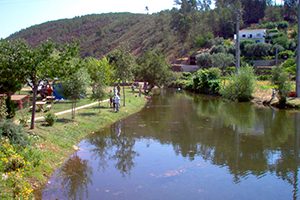
Casegas
Thirty kilometers from Covilhã, the former parish of Casegas (now belonging to the Union of Parishes of Casegas and Ourondo, being its headquarters) is located between the streams of Unhais and Casegas, in the foothills of Serra da Estrela, south of the county.
About the toponymic designation “Casegas”, different opinions have been raised until today. The origin of Casa Egas, an individual who in the past had great importance here, constitutes the most plausible hypothesis.
A curiosity about Casegas (and which may attest to its territorial importance) is the fact that it appears on the first known map of Portugal. Made in 1561 by Fernando Alvares Seco, it contains “Caregas”. In the work “O Mais Antigo Mapa de Portugal”, by Amorim Girão, Joaquim da Silveira and other authors, this region of the county is described and Casegas is clearly mentioned.
The parish church (1933-1934), dedicated to Saint Peter, is the richest example of ecclesiastical heritage.
With a subsoil rich in tin, wolfram, pyrite and other ores, mining is not, however, the main form of livelihood. The primary sector (agriculture, forestry and livestock) is dominant. Baking, metalwork, civil construction and oil mills are also a strong cornerstone of the parish’s economy.
Ourondo
Surrounded by the Serra da Estrela, Gardunha, Cebola and Maúnça, the parish of Ourondo was, before the administrative reorganization in 2013, one of the smallest in the Municipality of Covilhã, being enhanced in natural resources and endogenous diversity. Water is an element that abounds, due to the fact that the parish is located between the water courses of Ribeira da Caia, to the south, and Zêzere, to the north.
In 2013 it was added to the parish of Casegas, forming the Union of Parishes of Casegas and Ourondo, whose headquarters are in Casegas.
There is speculation about the name Ourondo and its origins. The existence of gold mines in the Moita site is one of the most plausible reasons (not least because of the geographical proximity to the Couto Mineiro area).
The Chapel of Saint John, whose pilgrimage is celebrated on the third weekend of June, the Parish Church, dating from the seventeenth century, endowed with four side altars and a high altar in gilded carving, the Chapel of Santo Amaro and the Chapel of Our Lady of Carmo, are examples of Ourondo’s heritage. In this regard, it is also worth mentioning the houses of remote times, consisting of manor houses and small palaces, built in schist and millheira stone.
Patrimony (Casegas)
Chapel of Souls (Casegas) or Chapel of Mercy
Saint Peter’s Church (Main)
Museum of Sacred Art
Monsignor Alves Brás Museum (founder of the Work of Santa Zita and the Secular Institute of Family Cooperators)
Roman bridge
Patrimony (Ourondo)
Sanctuary of Our Lady of Carmo
Chapels of Santo Amaro and S. João
Parish House
Community ovens
Fountains Old and the Mill
Ourondo and Casegas bridges (over Ribeira do Paul)
Stretch of the Caia stream
References
